Physical Address
304 North Cardinal St.
Dorchester Center, MA 02124
The term pyelonephritis encompasses infections of the renal parenchyma and pelvocaliceal system. Renal infections can be acute or chronic; unilateral or bilateral; and focal, multifocal, or diffuse. Potential complications include renal or perinephric abscess.
The most common cause of acute bacterial pyelonephritis is ascending infection from the lower urinary tract. Parenchymal renal infection may also occur as a result of hematogenous inoculation; this mechanism is most common in infants. Risk factors for pyelonephritis include high-grade vesicoureteral reflux, urinary tract congenital anomalies, voiding dysfunction, intermittent catheterization, and urinary diversion. Potential clinical manifestations include flank pain, abdominal pain, fever, pyuria, nausea, and vomiting. Young infants with pyelonephritis often have nonspecific findings such as irritability, vomiting, and poor feeding; fever is sometimes lacking.
Renal cortical scintigraphy with technetium-99m dimercaptosuccinic acid (DMSA) is highly sensitive (at least 90%) for the detection of acute bacterial pyelonephritis. Infected regions of the kidneys have diminished or absent radiotracer uptake, often with a spherical or flarelike pattern ( Fig. 114.1 ). The scintigraphic defect of a renal abscess is usually indistinguishable from that of uncomplicated parenchymal infection.
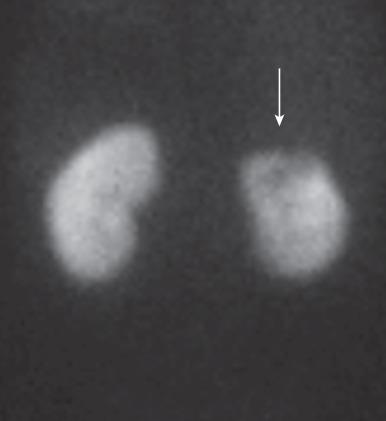
Contrast-enhanced computed tomography (CT) provides sensitivity similar to renal cortical scintigraphy for the diagnosis of acute bacterial pyelonephritis. CT findings include diminished nephrogram intensity; radially oriented linear streaks of diminished attenuation; round, masslike, or irregular hypoattenuating foci; wedge-shaped defects; and heterogeneous diminished enhancement throughout an enlarged kidney ( Fig. 114.2 ). Delayed CT images of the infected kidney show retention of contrast material in obstructed tubules. A parenchymal or perinephric abscess appears as a hypoattenuating focus, sometimes with a prominently enhancing rim.
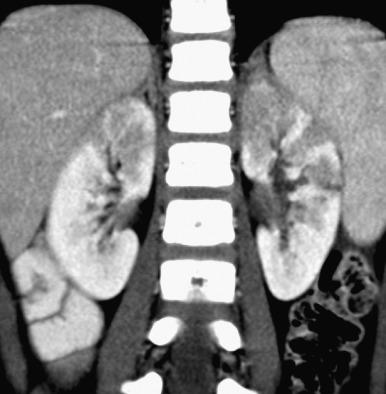
Renal parenchymal edema resulting from infection leads to diminished signal intensity on T1-weighted magnetic resonance imaging (MRI) and increased signal intensity on T2-weighted images. Alternatively, the kidneys may show one or more focal areas of decreased T2-weighted signal intensity ( Fig. 114.3 ). MRI findings can include nephromegaly, localized parenchymal expansion, diminished corticomedullary differentiation, parenchymal striation, perinephric edema/fluid, urothelial thickening, and decreased contrast enhancement of infected parenchyma.
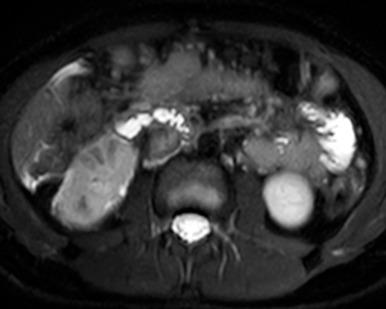
Reported sensitivities of sonography for the detection of acute bacterial pyelonephritis range from 25% to 50%. Potential findings include nephromegaly, abnormal parenchymal echogenicity, deficient corticomedullary differentiation, renal sinus hyperechogenicity, and urothelial thickening. Color Doppler or power Doppler imaging demonstrates diminished perfusion of the infected regions of parenchyma, sometimes with a wedge shape ( Fig. 114.4 ). A parenchymal abscess usually appears as a spherical avascular hypoechoic focus with acoustic enhancement. Occasionally, pus within the cavity results in an isoechoic or hyperechoic appearance. A perinephric abscess appears as a hypoechoic, sometimes complex fluid collection immediately peripheral to the renal capsule.
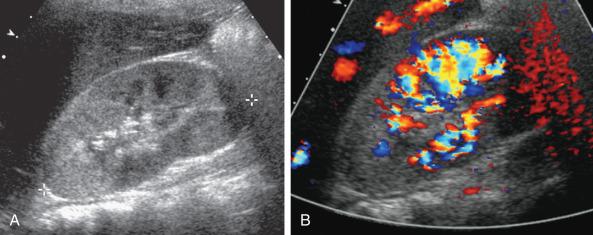
The treatment of bacterial pyelonephritis is antibiotic therapy. Follow-up sonography or scintigraphy serves to detect progression to scarring. Defects on renal cortical scintigraphy can persist for a few months after clinical resolution of the infection; therefore scintigraphy for scar detection should be delayed for at least 3 to 6 months.
Pyonephrosis is a bacterial infection of the kidney in which purulent material fills a dilated collecting system. Most often, a preexisting chronic urinary tract obstruction is present, such as ureteropelvic junction obstruction. Acute obstruction because of a calculus is an occasional cause in children. The clinical presentation of pyonephrosis is similar to that of other bacterial urinary tract infections. Fever, flank pain, pyuria, and hematuria are common.
Sonography shows echogenic material within a dilated pelvocaliceal system ( e-Fig. 114.5 ). The purulent material often layers in the dependent portions of the collecting system and may shift with changes in patient position. Thickening of the wall of the dilated renal pelvis is usually present. Echogenic foci in the urinary tract due to gas-forming organisms is an uncommon finding.
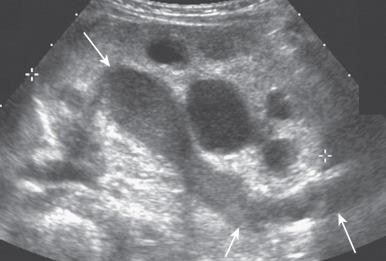
CT, MRI, or scintigraphy shows diminished function of the involved kidney. Contrast enhancement of the renal parenchyma is heterogeneous and delayed on CT. Excreted contrast material may outline filling defects in the dilated collecting system on delayed images. Debris usually is visible in the dilated renal collecting system on MRI. The renal parenchyma has abnormal heterogeneous signal intensity. The pus-filled collecting system is markedly hyperintense on diffusion-weighted images.
The treatment of pyonephrosis includes prompt initiation of aggressive antimicrobial therapy. Drainage of the obstructed collecting system often is required, usually by percutaneous nephrostomy. Surgical correction of an underlying obstruction is delayed until resolution of the acute infection.
Xanthogranulomatous pyelonephritis (XGP) is an uncommon form of severe chronic renal parenchymal infection that can sometimes mimic a renal tumor. The pathogenesis typically involves chronic infection of an obstructed kidney, often due to a large calculus. Diffuse involvement of the kidney is most common; segmental or focal forms also can occur, sometimes in association with obstruction of a duplicated collecting system or infundibulum. Clinical findings may be nonspecific and can include fever, flank pain, malaise, pyuria, weight loss, and anemia.
In the early stages of XGP, the involved portion of the kidney typically has an irregular hyperechoic character on sonography. With the diffuse form, the kidney may be massively enlarged but usually maintains a reniform shape. Echogenic foci with shadowing indicate calcifications. With progression, necrotic tissue and fluid are usually hypoechoic. Echogenic debris is sometimes visible within abscesses or the dilated collecting system.
CT of diffuse XGP typically demonstrates an enlarged nonfunctioning kidney that has multiple low-attenuation parenchymal foci ( Fig. 114.6 ). Most patients have a staghorn calculus in a contracted renal pelvis. Perinephric fat stranding is common. Perinephric abscesses are moderately hypoattenuating with peripheral enhancement. The pus-filled collecting system is hypoattenuating. Little or no contrast excretion occurs on delayed imaging. Regional retroperitoneal lymphadenopathy is common. With the focal form of XGP, CT typically demonstrates an expansile renal “mass”. Peripheral granulation tissue or compressed renal parenchyma may result in an enhancing peripheral rim. The involved renal parenchyma typically has low or intermediate signal intensity on T1-weighted MRI and high intensity on T2-weighted images.
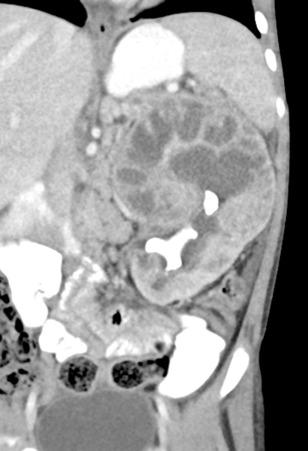
The usual treatment for XGP is antibiotic therapy followed by nephrectomy or heminephrectomy. A percutaneous biopsy occasionally is useful to allow differentiation from a neoplasm and to provide material for culture. With acute disease, percutaneous abscess drainage can serve as a temporizing measure.
Become a Clinical Tree membership for Full access and enjoy Unlimited articles
If you are a member. Log in here